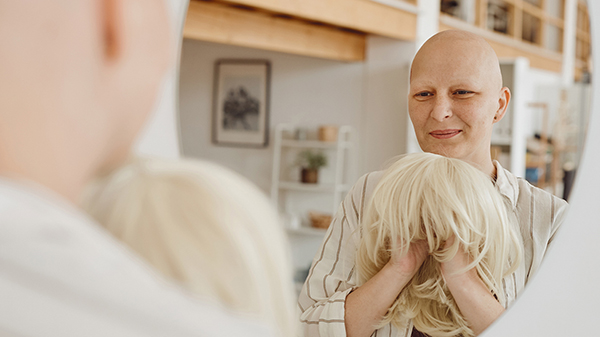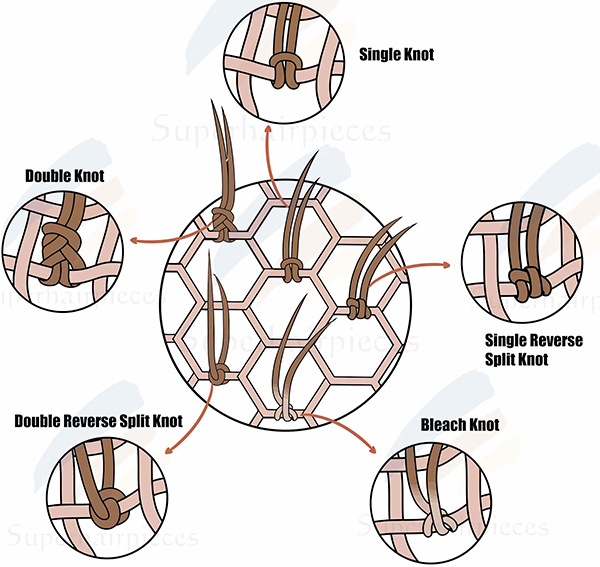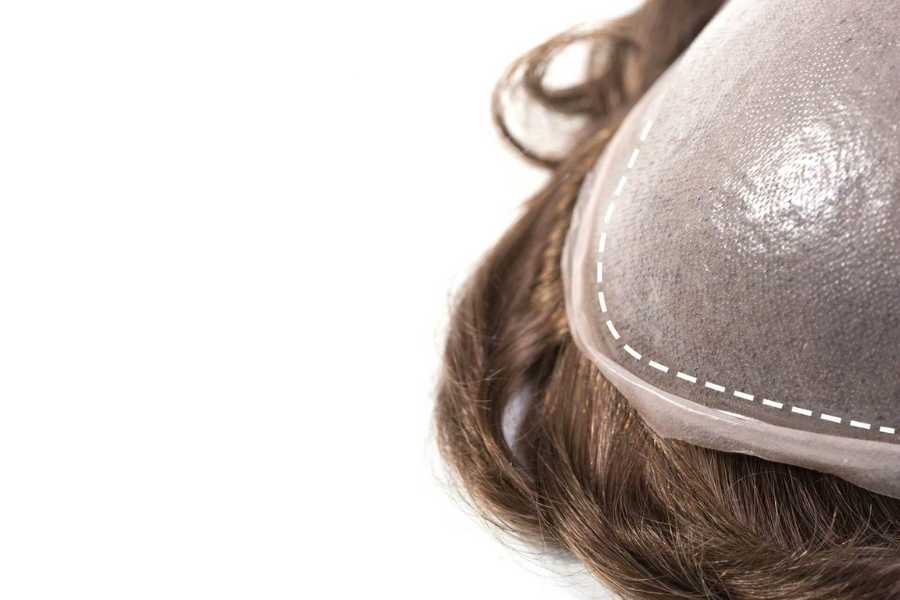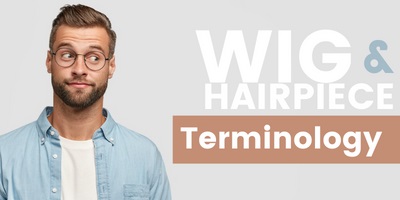Wig and hairpiece terminology you should know
Posted by Superhairpieces on Nov 10, 2021
Are you interested in getting your first non-surgical hair replacement system? Or maybe you already have a toupee or a wig, but are still a newcomer? Regardless of your experience level, the world of hair systems can be daunting and confusing with all the various terminology that is used. This can be the case even for the more experienced hairpiece wearers.
To help assist you with your hair system experience, Superhairpieces has provided the following glossary guide so you will know all the necessary toupee, hair topper, hair extension and wig terms.
COMMON HAIR SYSTEM TERMS

The following are terms that apply to all hair systems regardless of the type of hair system you are or will be wearing.
Adhesive
Adhesive refers to the substance used to attach your hair system to your scalp. Usually referred to as wig glue but can also be wig tape.
Alopecia

Alopecia is an autoimmune disease that causes hair loss for both men and women. It is also the medical term for male pattern and female pattern baldness.
Alopecia areata is the condition where round bald patches are formed while alopecia totalis is the condition that causes complete hair loss on the scalp. If you require a medical wig due to alopecia, you could get it covered by your insurance provider.
Base
The base is the part of the hair system where the hair gets attached. The material for the base can differ with each material having its own benefits and disadvantages.
Search men’s hair systems by base
Bonding
Bonding is the process of attaching a hair system to the wearer’s scalp using glue or tape.
Contour
Contour refers to the outline and shape of the head of the hair system wearer.
Search men’s hair systems by contour
Cuticles
Cuticles are the outer cellular layer of a hair shaft which strengthens and protects the hair.
Front hairline
The front hairline is the edges of a person’s hair on their forehead. The hairline usually starts four fingers above the eyebrows.
Hair
Human hair
Human hair is the real and natural hair made up of the protein keratin that is extracted from humans.
Synthetic hair
Synthetic hair is hair made up of acrylic or plastic fibres that is designed to look like and mimic human hair. They are much more affordable than human hair, but do not look, feel or last as long.
Kanekalon hair
Kanekalon hair is a type of synthetic hair. At Superhairpieces, Japanese Kanekalon synthetic fibers can be used for grey hair options.
Remy hair
Remy hair refers to hair that is kept intact with the hair cuticles going in the same direction. As a result, this leads to less shedding and tangling. Remy hair is regarded as the highest quality of human hair.
Chinese hair
Chinese hair is human hair extracted from ethnically-Chinese hair donors. This hair is strong, durable, thick and naturally straight. Also comes in black or brown colors.
European hair
European hair is human hair extracted from ethnic-European hair donors. This hair is soft and fine and comes in brown or blonde colors.
Indian hair
Indian hair is human hair extracted from ethnically-Indian hair donors. This hair is not as durable as Chinese hair, but is durable nonetheless in addition to being smooth, soft and naturally straight. Also comes in black or brown colors.
Virgin hair
Virgin hair refers to human hair that is not dyed, colored or chemically treated.
Yak hair
Yak hair refers to hair that is extracted from the actual yak animal. The texture is not like human hair as it is long, bushy, shaggy and thick.
Yaki hair
Yaki hair refers to human hair that imitates Yak hair. It is a lengthy process but Yaki hair tends to be more soft to touch than Yak hair.
Hair density
The number of strands of hair per square centimeter of your scalp. The higher the hair density, the more thick and voluminous the hair on the hair system.
How to choose the right hair density
100% Hand-Tied
This means all the hair in a hair system has been manually tied by a ventilation worker which creates an extremely natural look as a result.
Hair systems
Clip-on hair system
This is a hair system where rather than using glue or tape as the method of attachment, clips are used to attach it on the wearer.
You can see an example below:
Custom hair system
A custom hair system is a custom order of our in-stock hair systems where customers can choose between more complex customization options including but not limited to colors, size, dimensions, hair length, hair quality, hair type and the base construction.
Frontal hair system
A frontal hair system is a hair system that is designed to be worn towards or on the front hairline area of the wearer.
Full cap hair system
A full cap hair system is a hair system that utilizes a full cap which covers the wearer’s entire head. This is usually a feature of wigs for men and wigs for women.
In-stock hair system
An in-stock hair system is a regular unit available to retail and salon/professional clients. They come in set options with limited customization.
Knots

Bleached front knots
Bleached front knots are when the front hair knots of the hair system are bleached to make them undetectable and provide a realistic and natural looking front hairline.
Single knots
Single knots is a knotting method where strands of hair are used and knotted in the same direction.
Double knots
Double knots is a knotting method where strands of hair are used and knotted twice. This makes them very durable but not the most natural looking at the same time.
Single reverse split knot
Single reverse split knot is a knotting method where strands of hair are split into two with the gap providing movement while it also has more durability than a single knot. This method is usually used for poly skin bases.
Double reverse split knots
Double reverse split knots use the same knotting method as single reverse split knots but with the knots being knotted twice. This makes them more durable than a single reverse split knot, but also bigger making them visible at the root. This knotting method is usually used for lace bases but only when single strands are being knotted.
Invisible knots
Invisible knots are where one strand of hair is used per knot. This reduces the size of the knots making them look invisible and making your hair system look more natural.
V-Loop
V-loop is a knotting technique where the hair is looped into the hair system like a V-shape to provide the most natural looking hairline. This technique is usually used on skin base or thin skin hair systems.
Lace
Diamond Lace Top
Diamond lace top is a type of construction which is comfortable, durable and provides a natural look. This is also particularly ideal for those with sensitive skin.
Lace Front
Lace front is a type of construction with hair systems where the front utilizes a lace material while the rest of the base makes use of other materials.
French Lace
French lace is a type of lace material that while remaining natural looking, focuses more durability compared to a regular lace. It is lightweight and flexible.
Swiss Lace
Swiss lace is a type of lace material that provides even more of a natural look than a regular lace. However, it is more delicate as a result and also cannot hold as much hair as a French lace.
Fine welded mono lace
Fine welded mono lace is a type of lace construction where the lace does not require any binding as the threads are welded onto each other just like a screen window. The holes are made further apart making the unit more breathable than a fine mono lace material. This material is
360 Lace
A 360 lace is a type of lace construction where the lace is knotted around the perimeter of the head on the crown area. This allows for hairstyles such as a high ponytail. 360 lace is usually made from a combination of machine made and hand-tied.
Monofilament top
A monofilament top is a hair system that uses mono at the top of the base. The mono material usually contributes in making the hair system comfortable, breathable and more durable.
Polyurethane (poly skin)
Polyurethane is a common polymer used as a base material for hair systems. Also abbreviated as PU and referred to as poly skin, this material is known for providing a natural look with thin skin systems as well as being easy to clean, easy to install and easy to remove. However, they can lack durability and are not breathable.
Mils
Mils are the unit of measurement for the thickness of a base. It is essentially a thousandth of an inch so if a thin skin hair system has a thickness of 3 mils, it measures at 0.003 inches.
Ventilation
This is the process of attaching hair to a hair system. Can also refer to the breathability of a hair system.
TOUPEES

The following are terms more closely associated with toupees and Superhairpieces men’s hair systems in particular.
A series of men’s hair systems that are slightly more affordable than their equivalent in-stock hair systems while compromising on overall quality to allow for quicker production.
Injected skin
Injected skin is a technique which knots the hair into the poly material of a hair system to make it seem as if it is coming out naturally. It is usually used on skin base men’s toupees.
Pro Series
A series of men’s hair systems that come with three main features; colorless roots, nanotechnology invisible knots throughout the entire unit, and Premium European-like texturized Indian Remy hair.
Scallop front
Scallop front is a zigzag-shaped outline on the front hairline which makes for a more realistic and natural appearance. They are usually used on men’s hair systems.
WIGS, HAIR TOPPERS AND HAIR EXTENSIONS

The following are terms that apply to women’s hair systems such as wigs, hair toppers and hair extensions.
Different types of hair extensions
Polyurethane Tabs
Polyurethane tabs are present on the neck and temple areas of a wig where tape or glue can be applied for an easier and more secure application.
Silicone Strips and Tabs
Silicone strips and tabs are present on the temples and back area which allow the hair system to be securely attached to the head without the use of any adhesives.
Silicone Wig
A silicone wig is a wig made entirely of silicone. They are usually made for medical wigs and are very comfortable on the skin.
Hair
Single drawn hair
Single drawn hair in hair extensions means the hair contains multiple lengths that are mixed. They are usually thin towards the end and thick at the top.
Double drawn hair
Double drawn hair in hair extensions means the hair is of the same length, making it much thicker and durable than single drawn hair.
Injected silk
Injected silk is a technique which knots the hair into the silk material of a hair system to make it seem as if it is coming out naturally. It is usually used on mono tops and with women’s wigs in particular.
Vacuum Silicone Perimeter
A vacuum silicone perimeter sticks to the head like a vacuum for a secure and comfortable attachment.
Weave
A weave is a type of hair extension where hair wefts are sewn or stitched onto the braided hair of the wearer.
Are there any terms we’re missing or you feel should be added on this list? Let us know at support@superhairpieces.com!
------------------------
If you are interested in learning more about wigs, toupees or hairpieces, contact Superhairpieces today at 1-866-814-7879 or email us at sales@superhairpieces.com to set up your virtual appointment.
Need further information? Browse through our website at www.superhairpieces.com (US & International) or https://superhairpieces.ca/ (CAN)
Don’t forget tag us at @Superhairpieces and #Superhairpieces on your social media channels to get a shoutout!
 1 Likes
1 Likes



 EUR
EUR













